|
China : Shāndōng Shěng
8.7 km (5.4 miles) S of Wangtai, Shāndōng, China
Approx. altitude: 103 m
(337 ft)
([?] maps: Google MapQuest OpenStreetMap ConfluenceNavigator)
Antipode: 36°S 60°W
Accuracy: 5 m (16 ft)
Quality: good
Click on any of the images for the full-sized picture.
| 36°N 120°E (visit #4) |
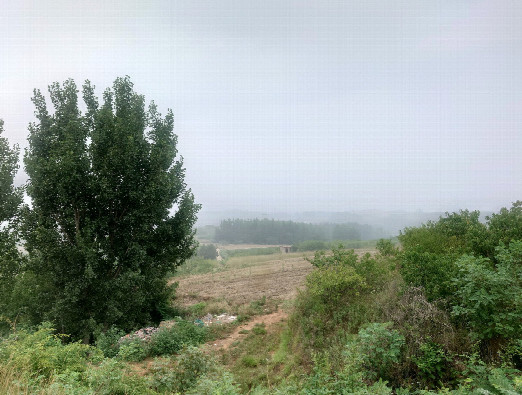 (visited by Tianming Yun, Geng Zhichao, Zichao Guo and Yang Cui) 28-Jun-2025 -- 我与 Zichao Guo、Geng Zhichao、CuiYang 一同探访了距离最近的经纬度交汇点——36°N 120°E。这是我们第一次造访此地。 上午十点多,Zichao Guo 驾车载着我们三人,从青岛北站附近出发,前往交汇点附近的王台镇共进午餐。大约半小时后,我们驶过壮观的胶州湾跨海大桥抵达王台镇。这是一个典型的山东小镇,规模不大,一眼便能望尽。镇上的建筑风格趋同,略显普通,像样的饭店选择不多,显得有些冷清。好在行前做足了功课,我们选中了评价不错的【董城驴肉火锅】。驴肉火锅的口感有些接近潮汕牛肉火锅,驴肉本身吃起来也带着几分牛肉的风味,整体味道尚可,但若专程为此而来,似乎不太值得。 餐毕启程时,天空飘起了小雨。Zichao Guo 继续驱车带我们开往交汇点方向。12:50左右,我们抵达姜家屯,注意到这里已有公交车可以直达,这在2025年已非难事。此时雨势渐大,大家纷纷拿出手机查看GPS定位,确认交汇点就在东北方向。于是我们顶着雨,沿着田埂在农田中穿行。 走了近一公里,终于冒雨抵达了目的地——36°N 120°E。站在点上,我们没敢乱动,赶紧让Geng Zhichao帮忙拍下了手机屏幕上精确显示的GPS坐标。 激动的心情稍稍平复后,我们开始将眼前的景象与2008年的记录照片进行比对。 朝北看: 几株树木挡住了视线——它们很可能正是2008年照片中那些小树长大后的样子。透过枝叶的缝隙,隐约可见有高铁呼啸而过,后来查询得知那是2018年通车的青盐铁路 朝南看: 与2008年相比,几乎完全认不出是同一个地方了。当年曾是一片玉米地良田的地方,如今杂草丛生,遍布拆除旧建筑遗留下的瓦砾。 朝西看: 变化更大,连地势似乎都改变了模样,加之雨雾弥漫,远处的山峰更是无处可寻。 朝东看: 情况也类似,不过地势大体得以保留,只是原来的土坡像是被人工削去了一块。 四向对比下来,17年间地貌的剧变让大家心情不免有些低落,当年的痕迹几乎被时光抹去了。就在此刻,北面一间废弃的田间农房引起了我们的注意——它似乎在2008年的老照片中露过面! 凑近一看,果然就是那间老屋!真没想到,历经17年风霜,周遭景物早已面目全非,唯有它还默默伫立在这片田野里,仿佛在等待后来者的到访。时间无情:本就破烂的窗户更加破败不堪,木质的窗框又少了几根,不过主体结构依然顽强;墙面的水泥大片剥落,露出了内里的石头和砖块。看着老屋在岁月侵蚀下形成的裂隙,我们灵机一动——这简直是藏宝的绝佳之所!于是果断在此处埋下了一个Geocaching宝藏,静待未来的寻宝者前来探索。 结束了在交汇点的短暂探索,大家决定合影留念,随后踏上了返程之路。 28-Jun-2025 -- June 28, 2025, Saturday: I visited the nearest latitudinal-longitudinal convergence point—36°N 120°E—with Zichao Guo, Geng Zhichao, and CuiYang. This was our first visit to this location. At around 10:00 AM, Zichao Guo drove the three of us from the vicinity of Qingdao North Station to Wangtai Town near the convergence point for lunch. About half an hour later, after crossing the spectacular Jiaozhou Bay Bridge, we arrived in Wangtai Town. This was a typical small town in Shandong, modest in size and easily traversed at a glance. The buildings shared a homogeneous style, appearing rather ordinary. Dining options were limited, giving the town a somewhat desolate feel. Thankfully, we had done our homework beforehand and chose the well-reviewed [Dongcheng Donkey Meat Hot Pot]. The hot pot tasted somewhat similar to the Chaoshan beef hot pot, while the donkey meat itself bore a resemblance to beef in flavor. While the overall taste was passable, it seemed hardly worth a dedicated trip solely for the meal. As we set out after lunch, light rain began to fall. Zichao Guo drove us toward the convergence point. Around 12:50, we reached Jiangjiatun and noted that buses could now take us directly there—no longer a difficult feat by 2025. The rain grew heavier, prompting us to check our GPS coordinates on our phones. We confirmed the confluence point lay northeast and proceeded along the field ridges through farmland, braving the downpour. After walking nearly a kilometer through the rain, we finally arrived at our destination—36°N 120°E. Standing precisely on the point, we hesitated to move and quickly asked Geng Zhichao to photograph the exact GPS coordinates displayed on the phone screen. Once our excitement subsided, we compared the current scene to archival photos from 2008: Facing North: Several trees now blocked the view—likely matured versions of the young saplings seen in the 2008 photo. Through gaps in the foliage, a high-speed train could be glimpsed speeding past. We later learned this was the Qingdao-Yancheng Railway, which opened in 2018. Facing South: Compared to 2008, the landscape was almost unrecognizable. Where fertile cornfields once stood, weeds now ran rampant amid debris from demolished buildings. Facing West: Changes were even more drastic. Even the topography appeared altered, and with the mist and rain obscuring the view, the distant mountains were nowhere to be seen. Facing East: The scene was similarly changed, though the landform remained broadly intact. The earthen slope looked as if part of it had been artificially leveled. The dramatic transformation of the landscape over 17 years cast a melancholic mood over us; the traces of the past had nearly vanished. Just then, an abandoned field hut to the north caught our attention—it seemed to have appeared in the 2008 photo! Approaching it, we confirmed it was indeed that same old hut. Against all odds, while everything else around it had changed beyond recognition over 17 years, this solitary structure still stood silently in the fields, almost as if waiting for future visitors to find it. Time had been unsparing: the already broken windows were further ravaged, with several wooden frames missing, but the main structure remained remarkably resilient. Cement plaster had peeled off large patches of the walls, exposing the stone and brick beneath. As we examined the fissures formed by years of weathering, inspiration struck—this was the perfect hiding place for treasure! We promptly buried a Geocaching treasure here, awaiting future seekers to discover it. After our brief exploration of the convergence point, we decided to take a group photo before embarking on the return journey. |
| All pictures |
| #1: Viewing the Confluence from a distance of 20 meters #2: View to the North #3: View to the South #4: View to the West #5: View to the East #6: Small house in the north #7: GPS Photo #8: group photo near 36°N 120°E ALL: All pictures on one page |

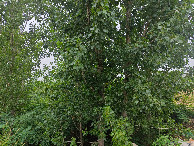
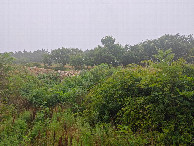
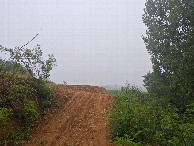
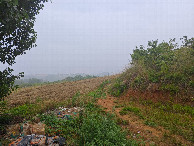
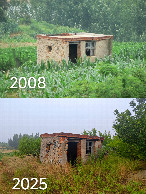
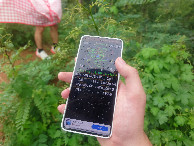
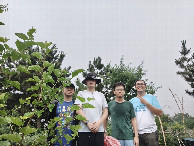
![Visit #3: [17-Jul-08] Visit #3: [17-Jul-08]](/cn/all/n36e120v3/preview.jpg)
![Visit #2: [25-Jun-06] Visit #2: [25-Jun-06]](/cn/all/n36e120v2/preview.jpg)
![Visit #1: [18-Jul-03] Visit #1: [18-Jul-03]](/cn/all/n36e120/preview.jpg)